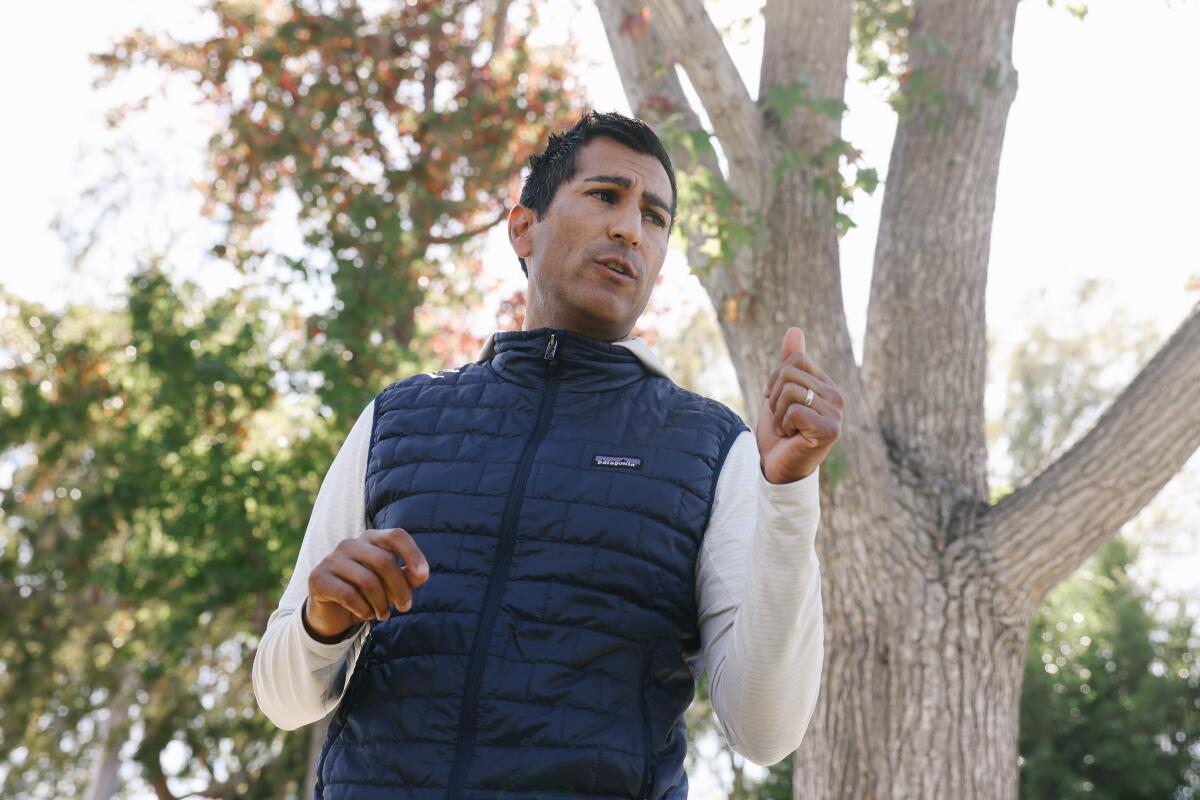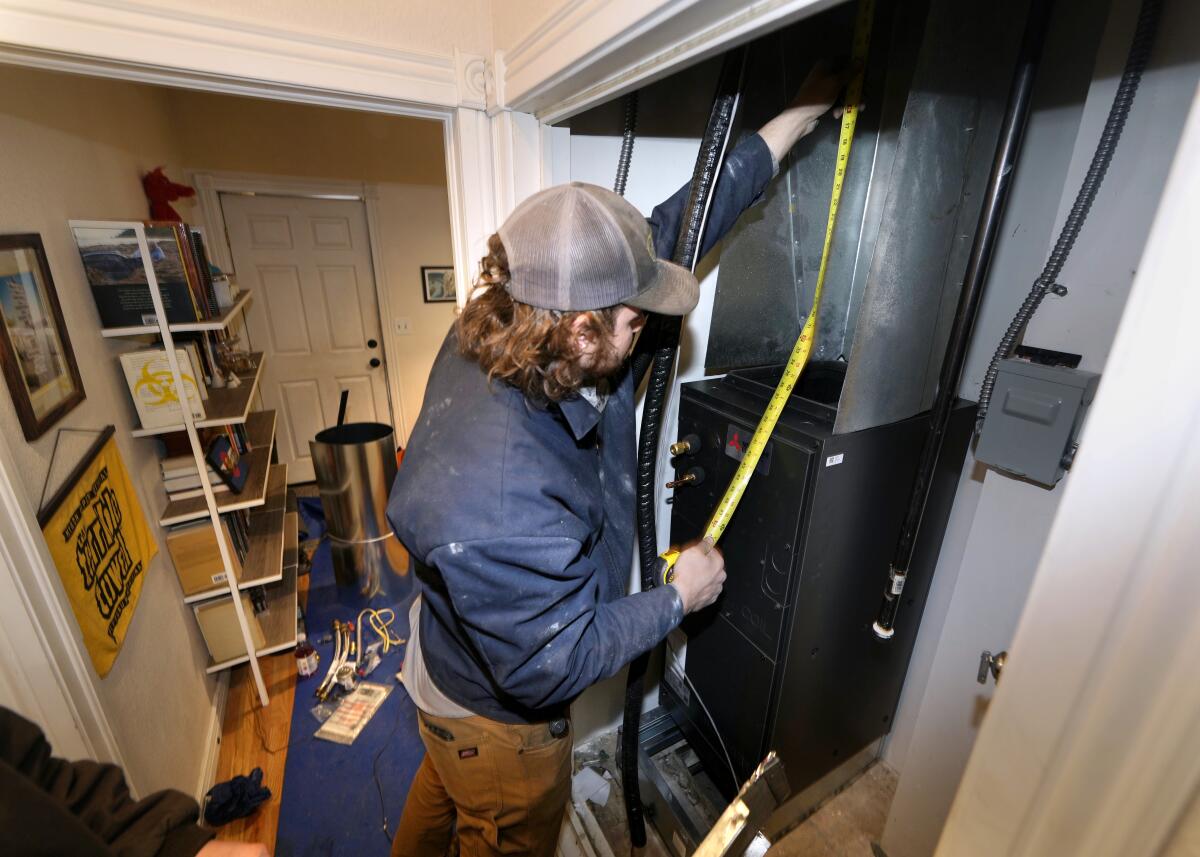California should move faster on clean energy. Some lawmakers want to take a break

- Share via
Assembly Speaker Robert Rivas, one of the most powerful people in Sacramento, just rammed a bill through his chamber that would place a six-year pause on new clean energy rules for homes in California, a few months after Los Angeles County was devastated by ferocious wildfires that demonstrated the urgency of climate change.
The Hollister Democrat says he’s not trying to stop progress on confronting the climate crisis. He’s trying to make housing less expensive, a top priority for Californians burdened by the state’s high costs.
You're reading Boiling Point
Sammy Roth gets you up to speed on climate change, energy and the environment. Sign up to get it in your inbox twice a week.
You may occasionally receive promotional content from the Los Angeles Times.
But his legislation, AB 306, has alarmed climate activists, appliance manufacturers and labor unions.
They say the bill, if approved by the Senate and signed by Gov. Gavin Newsom, would bring to a screeching halt one of California’s best tools for reducing heat-trapping emissions and local air pollution. It would stop state and local officials from approving most new building standards, including energy-efficiency requirements and codes encouraging electric appliances, until June 1, 2031.
In a letter this week, environmental groups — including the Natural Resources Defense Council, Earthjustice and Sierra Club California — said they were “concerned about the message sent to the rest of the country and the rest of the world that halting code development is somehow an appropriate response to the Los Angeles fires.”
“We cannot ignore the signal a bill like this would broadcast in the current political climate,” they wrote, referring to President Trump’s efforts to roll back climate regulations and promote planet-warming fossil fuels.
Since the 1970s, California’s efficiency codes for buildings and appliances have served as a global model. They’ve also saved Californians more than $100 billion on their utility bills, according to the state Energy Commission.
Recently, state officials have started encouraging home builders and families to switch from gas space and water heaters to electric alternatives called heat pumps. Heat pumps are not only more efficient, leading to lower utility bills, they also don’t release heat-trapping emissions — or unhealthy, smog-forming nitrogen oxide pollution.
But if AB 306 becomes law, the Energy Commission would be barred from even considering code updates for six years. That’s a veritable eternity for a state that wants to be a global climate leader, especially when scientists are urging humanity to slash carbon emissions more than 40% by 2030 — a goal California is not on track to meet.

Because the Energy Commission updates the building code every three years, the bill’s approval would mean that no new code would take effect until 2035, after an update already scheduled to take effect next year.
AB 306 would affect existing homes in addition to new construction. Most problematic for some climate activists, the bill would prohibit cities and counties from adopting “reach codes” that go beyond statewide standards by encouraging families to replace broken air conditioning units with electric heat pumps capable of both cooling and heating. That way, when your gas furnace eventually breaks, there’s no need to replace it.
Andy Shrader, who served as policy director for former L.A. City Councilmember Paul Koretz, said AB 306 would “hamstring the ability of [cities] to innovate via their building codes — this at a time when innovation is essential to address the multiple and complex existential crises facing us all,” including climate change and Trump.
“We absolutely must get methane gas out of homes and businesses to make them safer,” he told lawmakers last month at a hearing of the Assembly’s Housing and Community Development Committee.
Several lawmakers on the committee expressed reservations about AB 306.
Assemblymember Ash Kalra (D-San José), whose strong climate track record has earned him a spot in California Environmental Voters’ Hall of Fame, said he had “some heartburn” about the bill — especially the idea of delaying updated statewide building codes for nearly a decade. Assemblymember Lori Wilson (D-Suisun City) said she was “slightly concerned” about limiting the ability of local governments to set their own building standards.
But ultimately, all the concerned lawmakers voted “yes” — as did everyone else on the committee, and everyone who weighed in on a second committee. The bill sailed through the Assembly last week on a 71-0 floor vote.
I reached out to a few lawmakers in California Environmental Voters’ Hall of Fame to ask about why they hadn’t opposed the legislation. I didn’t hear back from spokespeople for Assemblymember Isaac Bryan (D-Los Angeles), who voted “yes,” or Assemblymember Rick Chavez Zbur (D-Los Angeles), who didn’t record a vote.
I did get an email from a spokesperson for Assemblymember Al Muratsuchi (D-Rolling Hills Estates).
“I’m sorry but he will not be able to contribute to the story,” she said.
Clearly, passing AB 306 was a priority for Rivas. The question is, why?
The answer is the housing crisis, according to the Assembly speaker’s office.

It’s no secret that homes in California are in short supply and increasingly unaffordable, prompting many people to leave or consider leaving the state. For Rivas, it seems anything that might drive up the cost of building a new home or replacing an appliance — even an efficiency code that would save a homeowner or renter thousands of dollars in the long run by reducing their utility bill — is an obstacle that Californians can’t afford right now.
“The larger goal is to address the statewide housing crisis by accelerating production of supply to improve overall affordability,” Nick Miller, Rivas’ director of communications, said in an email.
“Our already strong climate goals will remain on the books,” he added.
But shouldn’t California be doing more on climate, not standing pat? When I asked Miller whether the state can really afford a six-year break from new building codes given the fires, storms and heat waves of the climate crisis, he emphasized the progress the state has already made — including the building code update scheduled to take effect next year, which will incentivize heat pumps for space and water heating in new homes.
“If building with electric is cheaper, then people should do it,” Miller said.
Fair enough. But for home builders, contractors and consumers, old habits are hard to break — hence the value of efficiency standards that encourage people to ditch gas. Building codes also help bring down the costs of new technologies — electric heat pumps, for instance — by spurring widespread adoption.
It’s also not clear if pausing building codes would make housing much cheaper.
The California Building Industry Assn. believes it would. The trade group, which supports AB 306, has estimated the statewide building code taking effect next year will add $2,500 to the cost of a new home. Additional electric-appliance rules could raise prices even more, according to Chris Ochoa, a senior counsel at the trade group.
“We have to balance electrification with affordability,” he said.
It’s a reasonable argument. But it’s not clear whether it holds up.
The Energy Commission, for instance, estimates that next year’s building code update will add just $757 to the cost of a new home. There are also heat pump rebates for replacing appliances in existing homes, to help lower-income families afford a technology that’s more expensive upfront but will save them money in the long run.
Merrian Borgeson, a California policy director at the Natural Resources Defense Council, said she thinks there’s “generally positive intent” behind AB 306. But she doesn’t think the bill would help create more housing.
“The solution they’re proposing doesn’t address any of the problems they’re raising,” she said.

It’s not just environmentalists sounding the alarm. A long list of trade groups, including the American Chemistry Council, the National Electrical Manufacturers Assn. and the Earthquake Engineering Research Institute, signed a letter raising concerns about the structural safety of buildings, among other issues with the bill.
Also opposed: the State Assn. of Electrical Workers, the State Pipe Trades Council and the Western States Council of Sheet Metal Workers, labor groups whose members construct and upgrade homes. Scott Wetch, an influential lobbyist for those groups, wrote that AB 306 would “set back decarbonization, energy efficiency, water efficiency, green building technology and modernization of the codes for almost a decade.”
In the face of so much opposition, it’s no wonder Rivas has framed AB 306 as a response to the L.A. wildfires.
To be clear, Rivas’ spokesperson insisted to me that it’s not primarily a fire relief bill. But when Rivas announced it in January, it was part of a package of bills headlined, “Legislation Announced to Help Fire Victims.”
And before the Assembly voted last week to pass AB 306 and most of the rest of the package, Rivas discussed the need to make housing more affordable — and to help L.A. County fire victims rebuild as quickly as possible.
“With our vote today, this Assembly will be following through on our commitment to support and assist recovery efforts in Los Angeles,” Rivas said. “Each of these bills contain an urgency clause … because we must move fast to help all Angelenos and all residents of our state.”
This is where Rivas really loses me.
If the Assembly speaker wanted to start a nuanced discussion about electrification and affordability, fine. But he hasn’t done that. He’s forced a bill through the Assembly that assumes California’s climate policies are driving up housing costs. It would deal a harsh blow to our ability to address a major source of climate pollution.
Similarly, if Rivas wanted to approach housing as a climate solution, that would be great. Building more homes in densely populated urban areas is super important for cutting emissions, because it can limit the number of miles that people need to drive to their jobs — a point that was raised by AB 306’s other author, Assemblymember Nick Schultz (D-Burbank), at last month’s housing committee hearing.
“The transportation sector is probably the single largest-emitting, polluting sector of our economy. When people can afford to live in proximity to where they work, that gets them out of the car driving,” Schultz said.
Unfortunately, that’s not the thrust of AB 306. Rather than take a targeted approach to shifting building codes in ways that might support climate-smart housing development, the bill simply takes for granted that California has nothing left to gain and everything to lose from setting any new standards over the next six years.
It’s no wonder climate champions like Bryan and Muratsuchi don’t want to talk about why they voted “yes.”
This is the latest edition of Boiling Point, a newsletter about climate change and the environment in the American West. Sign up here to get it in your inbox. And listen to our “Boiling Point” podcast here.
For more climate and environment news, follow @Sammy_Roth on X and @sammyroth.bsky.social on Bluesky.
Insights
L.A. Times Insights delivers AI-generated analysis on Voices content to offer all points of view. Insights does not appear on any news articles.
Perspectives
The following AI-generated content is powered by Perplexity. The Los Angeles Times editorial staff does not create or edit the content.
Ideas expressed in the piece
- Housing affordability as a priority: Assembly Speaker Robert Rivas argues that AB 306 aims to address California’s housing crisis by reducing construction costs, which he claims are exacerbated by new clean energy regulations. He emphasizes accelerating housing supply to improve affordability, citing the need to balance climate goals with economic pressures[6][1][2].
- Pausing codes to streamline recovery: Proponents frame the bill as urgent wildfire relief, asserting that halting new building standards will expedite rebuilding in fire-ravaged areas like Los Angeles County. The pause is portrayed as temporary, with existing climate policies remaining intact[6][1].
- Economic feasibility of electrification: Supporters, including the California Building Industry Association, argue that delaying codes will prevent upfront cost increases for homeowners and builders. They claim heat pumps and other electric appliances remain optional if cost-effective, avoiding mandates that could strain housing budgets[6][3].
Different views on the topic
- Threat to climate progress: Environmental groups, including the Natural Resources Defense Council and Sierra Club California, warn that AB 306 undermines California’s leadership by halting energy-efficient building codes for six years—a critical period for reducing emissions. They stress that codes drive innovation and cost reductions for clean technologies like heat pumps[6][4][5].
- Local autonomy and safety concerns: Critics highlight the bill’s restriction on cities and counties from adopting “reach codes” that exceed state standards. Opponents argue this stifles local solutions to air pollution, gas phaseouts, and wildfire resilience, jeopardizing public health and safety[6][4].
- Economic and labor backlash: Labor unions, including the State Association of Electrical Workers, oppose the bill, noting it would stall job creation in green construction and delay modernization of building safety standards. Trade groups also warn it could weaken structural resilience and long-term utility savings for households[6][3][4].
Toward a more sustainable California
Get Boiling Point, our newsletter exploring climate change, energy and the environment, and become part of the conversation — and the solution.
You may occasionally receive promotional content from the Los Angeles Times.




